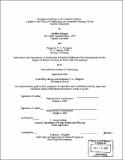Switches and mortar in the Internet's shadow : a study of the effects of technology on competitive strategy for the Internet's landlords
Author(s)
Morgan, Geoffrey (Geoffrey Martin), 1966-; Pettigrew, Benjamin V. A. 1974-
DownloadFull printable version (20.28Mb)
Other Contributors
Massachusetts Institute of Technology. Dept. of Architecture.
Advisor
Gloria Schuck.
Terms of use
Metadata
Show full item recordAbstract
Communications technology has experienced a period of explosive growth, driven by a confluence of legal, political and technical factors including the following: the 1968 Carter Phone and 1980's competitive carrier decisions, the 1984 divestiture of AT&T, the Telecommunications Act of 1996, the development and standardization of new technologies, and the proliferation of the Internet and World Wide Web. This thesis asks the fundamental questions: How has the rapid growth of the Internet and other communications technologies changed the competitive strategy of commercial tenants, and how have these changes affected commercial real estate developers? This study proposes that developers and landlords need to use more forward-looking theories of competitive strategy in order to understand the current and future real estate needs of technology-driven commercial tenants. Telecommunications deregulation and the growth of the Internet led to the creation of a new and rapidly growing high technology industry and commercial tenancy. Deregulation and the Internet also transformed the way traditional commercial real estate uses information technology, encouraged the forging of partnerships between commercial real estate professionals and "last mile" information technology contractors, and resulted in the creation of a new commercial real estate product-the telecom hotel.' Current literature suggests traditional commercial tenants might differ from Internet-based business tenants in four general areas of the development process: feasibility, site selection, design and building operations. The proliferation of the Internet as a catalyst for new real estate products, commercial tenants and partnerships, and the observed differences in development practices between traditional and commercial tenants are both clues to fundamental differences between these two tenants' competitive strategies. It is possible to understand these clues to tenant behavior by taking an in-depth look at how these two tenants compete in their respective industries. Traditional commercial business tenants appear to conform to Michael Porter's theories on competitive strategy and advantage. High-tech tenant's competitive strategies seem to be more accurately reflected by Gary Hamel and C.K. Prahalad's model of competition for the future. These two theories, and the industries they represent, differ in four dimensions: Future versus Past/Present orientation, technology use, rate of growth, and resource use. In comparing three case studies on these four strategic dimensions, this thesis concludes that Porter's more stable, efficiency-oriented model does explain the strategy of Northwestern Mutual, a large insurance organization. Hamel and Prahalad's model better explains the hectic, high growth, future orientation of Akamai and YankeeTek Incubator as well as Teleplace, a telecom hotel service company. Hamel and Prahalad and Porter's frameworks explain significant discrepancies between predicted development practices based on current industry thinking, and observed development practices based on these in depth case studies. This thesis thus verifies a need by real estate developers and landlords to use forward-looking theories of competitive strategy when examining the current and future needs of hightech tenants.
Description
Thesis (S.M.)--Massachusetts Institute of Technology, Dept. of Architecture, 2000. Includes bibliographical references (leaves 132-138).
Date issued
2000Department
Massachusetts Institute of Technology. Department of ArchitecturePublisher
Massachusetts Institute of Technology
Keywords
Architecture.